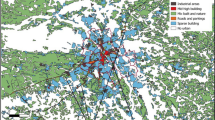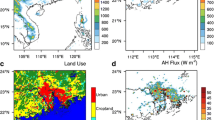Abstract
A three-dimensional mesoscale model was used to study the effect of an urban heat island in a relatively complex situation. A heat emission inventory was carried out for an urban airshed thatincludes sources such as motor vehicles, waste heat from industries and electricity consumption. To demonstrate the relative significance of anthropogenic heat flux and variant surface characteristics, three model simulations were conducted. In the first simulation, anthropogenic heat flux was ignored and non-variant surface properties were considered for the entire modelling domain. In the second simulation, variant surface characteristics were considered. While in the third simulation, gridded anthropogenic heat flux and variant surface characteristic were utilised. From these experiments, it was inferred that an additional source of heat in urban areas can substantially affect the wind and temperature regime under light wind conditions. During the day, the anthropogenic heat flux has minimum effect on the urban temperature, however it magnifies the intensity of the convergence near the urban areas.
Similar content being viewed by others
References
Abbs, D. J.: 1986, ‘Sea Breeze Interactions along a Concave Coastline in Southern Australia: Observation and Numerical Modelling Study’ Mon. Wea. Rev. 114, 831-848.
Arritt, R. W., Pielke, R. A., and Segal, M.: 1988, ‘Variation of Sulphur Dioxide Deposition Velocity Resulting from Terrain-Forced Mesoscale Circulations’ Atmos. Environ. 22, 715-723.
Avissar, R.: 1996, ‘Potential Effects of Vegetation on the Urban Thermal Environment’ Atmos. Environ. 30, 437-448.
Commonwealth Department of Primary Industries and Energy: 1996, Australian Petroleum Statistics, 20 pp.
Department of Environment: 1997a, South East Queensland Regional Air Quality Strategy-Air Quality in the South East Queensland Airshed, State of Knowledge Report, 44 pp.
Department of Environment: 1997b, Air Emission Inventory-South East Queensland Airshed, Technical Report, South East Queensland Regional Air Quality Strategy, 18 pp.
Hyde, R., Young, M., Hurley, P., and Manins, P.: 1997, Metropolitan Air Quality Study-Air Movements, EPA NSW and Coffey Partners International, Sydney, 388 pp.
Katestone Scientific: 1997, Anthropogenic Influences in Australian Urban Airshed, A Report to the Australian Academy of Technological Science and Engineering, 224 pp.
Mahrer, Y. and Pielke, R. A.: 1977, ‘The Effects of Topography on Sea and Land Breeze in a Two-Dimensional Numerical Model’ Mon. Wea. Rev. 105, 1151-1162.
Physick, W. L., Noonan, J. A., and Manins P. C.: 1991, Air Quality Modelling Study of the Hunter Valley. Phase I: Emitters in the Upper Hunter. CSIRO Division of Atmospheric Research, A report to the Electricity Commission of New South Wales, 145 pp.
Pielke, R. A.: 1974, ‘A Three Dimensional Numerical Model of the Sea Breeze over South Florida’ Mon. Wea. Rev. 102, 115-134.
Pielke, R. A.: 1984, Mesoscale Meteorological Modelling, Academic Press Inc., 612 pp.
Pielke, R. A. and Mahrer, Y.: 1978, ‘Verification Analysis of the University of Virginia Three Dimensional Mesoscale Model Prediction over South Florida for July 1, 1973’ Mon. Wea. Rev. 106, 1568-1589.
Pielke, R. A., McNider, R. T., Segal, M., and Mahrer, Y.: 1983, ‘The Use of Mesoscale Numerical Model for Evaluation of Pollution Transport and Diffusion in Coastal Regions and over Complex Terrain’ Bull. Amer. Meteorol. Soc. 64, 243-249.
Small, R. D.: 1991, ‘Environmental Impact of Fires in Kuwait’ Nature 350, 11-12.
Steyn, D. G. and McKendry, I. G.: 1988, ‘Quantitative and Qualitative Evaluation of a Threedimensional Mesoscale Numerical Model Simulation of a Sea Breeze in Complex Terrain’ Mon. Wea. Rev. 116, 1914-1926.
Stull, R. B.: 1994, An Introduction to Boundary Layer Meteorology, Kluwer Academic Publishers, Dordrecht, 666 pp.
Author information
Authors and Affiliations
Rights and permissions
About this article
Cite this article
Khan, S.M., Simpson, R.W. Effect Of A Heat Island On The Meteorology Of A Complex Urban Airshed. Boundary-Layer Meteorology 100, 487–506 (2001). https://doi.org/10.1023/A:1019284332306
Issue Date:
DOI: https://doi.org/10.1023/A:1019284332306




